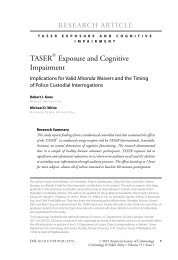1qaSADJ
1qaSADJ
1qaSADJ
Create successful ePaper yourself
Turn your PDF publications into a flip-book with our unique Google optimized e-Paper software.
Special Focus:<br />
Writing Persuasively<br />
Similar to the second premise of a syllogism, it serves as a guarantee, linking the claim to<br />
the support.<br />
Backing consists of further assurances or data without which the warrant lacks authority.<br />
A qualifier, when used (e.g., “usually,” “probably,” “in most cases,” “most likely”), restricts<br />
the terms of the claim and limits its range, indicating the degree of strength delivered by<br />
the warrant.<br />
A reservation explains the terms and conditions necessitated by the qualifier.<br />
A rebuttal gives voice to objections, providing the conditions that might refute or rebut<br />
the warranted claim.<br />
The following diagram illustrates the Toulmin model:<br />
Data<br />
Claim<br />
↑ ↑ ↑<br />
Warrant Qualifier Reservation<br />
↑<br />
Backing<br />
Toulmin states it this way: Data, so (qualifier) claim, since warrant, on account of backing,<br />
unless reservation. A good classroom model is that used by Annette Rottenberg and<br />
Kathleen Bell and others: Because (data as support), therefore, or so (qualifier?) (claim),<br />
since (warrant), because, or on account of (backing), unless (reservation).<br />
Students find the form to be highly useful once they get it, although it isn’t easy at<br />
first. It is good practice to begin in class with a simple illustration. For example, at<br />
the board the teacher might write, “Because it is raining, I should take my umbrella,”<br />
demonstrating support for a claim. The teacher would ask the students to supply the<br />
warrant: “since it will keep me dry.” Students immediately recognize the tacit assumption<br />
given explicit expression in the warrant. They will then provide the backing, “that the<br />
material is impervious or waterproof,” and the reservation, “unless there is a hole in it.”<br />
The following diagram illustrates this argument—a simple one indeed, but one that<br />
demonstrates the process.<br />
AP® English Language and Composition: 2006–2007 Workshop Materials 25



